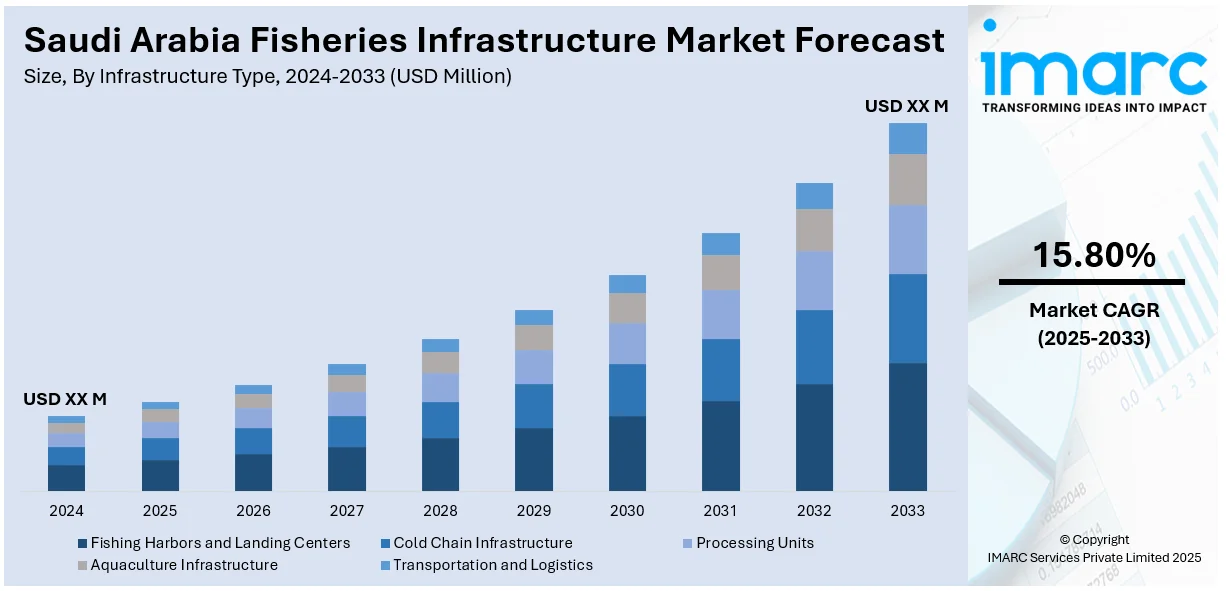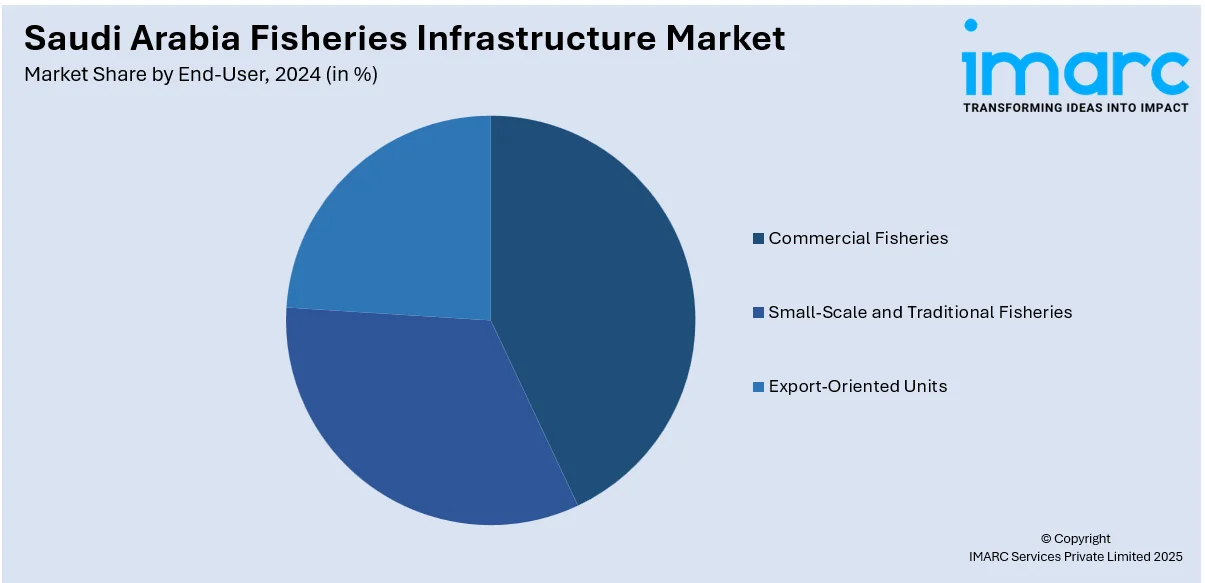
Saudi Arabia Fisheries Infrastructure Market Size, Share, Trends and Forecast by Infrastructure Type, Sector, End-User, and Region, 2025-2033
Saudi Arabia Fisheries Infrastructure Market Overview:
The Saudi Arabia fisheries infrastructure market size is anticipated to exhibit a growth rate (CAGR) of 15.80% during 2025-2033. The market is propelled by strategic government initiatives, technological advancements, and a growing demand for sustainable seafood. These factors collectively contribute to the market's expansion, enhancing food security and economic diversification. Consequently, the Saudi Arabia fisheries infrastructure market share is experiencing significant growth.
|
Report Attribute
|
Key Statistics
|
|---|---|
|
Base Year
|
2024 |
|
Forecast Years
|
2025-2033
|
|
Historical Years
|
2019-2024
|
| Market Growth Rate 2025-2033 | 15.80% |
Saudi Arabia Fisheries Infrastructure Market Trends:
Strategic Government Investments and Vision 2030 Alignment
The Saudi Arabia fisheries infrastructure market growth is strongly supported by targeted government investments aligned with Vision 2030. Saudi Arabia's National Fisheries Development Program exemplifies this approach, with over $4 billion allocated to develop aquaculture capabilities, improve fish hatcheries, and enhance fish feed production. These initiatives aim to scale up national seafood output to 600,000 tons annually by 2030, addressing food security and diversifying the non-oil economy. Additionally, the government is facilitating foreign partnerships, streamlining regulatory frameworks, and offering subsidies to encourage private sector engagement. Such structured policies and funding mechanisms are rapidly transforming the sector, fostering sustainable infrastructure growth and increasing production capacity, which collectively contribute to the Saudi Arabia fisheries infrastructure market growth.

Technological Advancements in Aquaculture Practices
Technological innovation is a major driver in the Saudi Arabia fisheries infrastructure market growth. The introduction of advanced aquaculture systems, such as Recirculating Aquaculture Systems (RAS), AI-based water quality sensors, and automated feeding systems, is revolutionizing productivity and sustainability. These technologies reduce environmental impact, lower operational costs, and optimize resource use. For instance, AI-driven monitoring has improved fish health management, leading to lower mortality rates and better yield predictability. In particular, smart aquaculture solutions have shown a 21% reduction in feed waste while maintaining false positive detection rates below 4%. Since feed accounts for 50–80% of aquaculture costs, the system significantly cuts expenses and enhances fish health and growth. As Saudi Arabia accelerates its digital transformation, the integration of such high-efficiency systems is expanding across major facilities, directly enhancing infrastructure resilience and promoting long-term Saudi Arabia fisheries infrastructure market growth.
Saudi Arabia Fisheries Infrastructure Market Segmentation:
IMARC Group provides an analysis of the key trends in each segment of the market, along with forecasts at the country/regional levels for 2025-2033. Our report has categorized the market based on infrastructure type, sector, and end-user.
Infrastructure Type Insights:
- Fishing Harbors and Landing Centers
- Cold Chain Infrastructure
- Cold Storage
- Ice Plants
- Processing Units
- Fish Processing Plants
- Packaging Units
- Aquaculture Infrastructure
- Hatcheries
- Feed Plants
- Transportation and Logistics
- Refrigerated Vehicles
- Supply Chain
The report has provided a detailed breakup and analysis of the market based on the infrastructure type. This includes fishing harbors and landing centers, cold chain infrastructure (cold storage and ice plants), processing units (fish processing plants and packaging units), aquaculture infrastructure (hatcheries and feed plants), and transportation and logistics (refrigerated vehicles and supply chain).
Sector Insights:
- Marine Fisheries
- Inland Fisheries
- Aquaculture
A detailed breakup and analysis of the market based on the sector have also been provided in the report. This includes marine fisheries, inland fisheries, and aquaculture.
End-User Insights:

- Commercial Fisheries
- Small-Scale and Traditional Fisheries
- Export-Oriented Units
A detailed breakup and analysis of the market based on the end-user have also been provided in the report. This includes commercial fisheries, small-scale and traditional fisheries, and export-oriented units.
Regional Insights:
- Northern and Central Region
- Western Region
- Eastern Region
- Southern Region
The report has also provided a comprehensive analysis of all the major regional markets, which include Northern and Central Region, Western Region, Eastern Region, and Southern Region.
Competitive Landscape:
The market research report has also provided a comprehensive analysis of the competitive landscape. Competitive analysis such as market structure, key player positioning, top winning strategies, competitive dashboard, and company evaluation quadrant has been covered in the report. Also, detailed profiles of all major companies have been provided.
Saudi Arabia Fisheries Infrastructure Market News:
- In May 2025, a Norwegian company, MAT-KULING, partnered with Saudi Arabia’s National Aquaculture Group (NAQUA) to develop a cutting-edge barramundi hatchery. This facility is set to be the most advanced in the region, aiming to support sustainable growth and increase production capacity. The collaboration highlights strong Norwegian-Saudi ties in aquaculture and aligns with Saudi Arabia’s Vision 2030 goals to boost local fish production and industry modernization.
- In October 2024, the Saudi Fisheries Company (Alasmak), partially owned by the Public Investment Fund, established a new aquaculture subsidiary in Riyadh with a capital of SAR 100,000. This move aligns with the company's strategy to restructure its activities and investments in the aquaculture sector. The establishment of this subsidiary is part of broader efforts to boost domestic fish production, improve quality, diversify species, and encourage investment in line with Saudi Arabia's Vision 2030 goals.
- In June 2024, KAUST and MEWA formed a partnership to revolutionize Saudi Arabia's aquaculture sector. This collaboration aims to increase local production from 280,000 tons in 2024 to 530,000 tons per year by 2030. The initiative focuses on fostering sustainable growth in the aquaculture industry while addressing key issues like production expenses, water shortages, and environmental impacts.
Saudi Arabia Fisheries Infrastructure Market Report Coverage:
| Report Features | Details |
|---|---|
| Base Year of the Analysis | 2024 |
| Historical Period | 2019-2024 |
| Forecast Period | 2025-2033 |
| Units | Million USD |
| Scope of the Report |
Exploration of Historical Trends and Market Outlook, Industry Catalysts and Challenges, Segment-Wise Historical and Future Market Assessment:
|
| Infrastructure Types Covered |
|
| Sectors Covered | Marine Fisheries, Inland Fisheries, Aquaculture |
| End-Users Covered | Commercial Fisheries, Small-Scale and Traditional Fisheries, Export-Oriented Units |
| Regions Covered | Northern and Central Region, Western Region, Eastern Region, Southern Region |
| Customization Scope | 10% Free Customization |
| Post-Sale Analyst Support | 10-12 Weeks |
| Delivery Format | PDF and Excel through Email (We can also provide the editable version of the report in PPT/Word format on special request) |
Key Questions Answered in This Report:
- How has the Saudi Arabia fisheries infrastructure market performed so far and how will it perform in the coming years?
- What is the breakup of the Saudi Arabia fisheries infrastructure market on the basis of infrastructure type?
- What is the breakup of the Saudi Arabia fisheries infrastructure market on the basis of sector?
- What is the breakup of the Saudi Arabia fisheries infrastructure market on the basis of end-user?
- What is the breakup of the Saudi Arabia fisheries infrastructure market on the basis of region?
- What are the various stages in the value chain of the Saudi Arabia fisheries infrastructure market?
- What are the key driving factors and challenges in the Saudi Arabia fisheries infrastructure market?
- What is the structure of the Saudi Arabia fisheries infrastructure market and who are the key players?
- What is the degree of competition in the Saudi Arabia fisheries infrastructure market?
Key Benefits for Stakeholders:
- IMARC’s industry report offers a comprehensive quantitative analysis of various market segments, historical and current market trends, market forecasts, and dynamics of the Saudi Arabia fisheries infrastructure market from 2019-2033.
- The research report provides the latest information on the market drivers, challenges, and opportunities in the Saudi Arabia fisheries infrastructure market.
- Porter's five forces analysis assist stakeholders in assessing the impact of new entrants, competitive rivalry, supplier power, buyer power, and the threat of substitution. It helps stakeholders to analyze the level of competition within the Saudi Arabia fisheries infrastructure industry and its attractiveness.
- Competitive landscape allows stakeholders to understand their competitive environment and provides an insight into the current positions of key players in the market.
Need more help?
- Speak to our experienced analysts for insights on the current market scenarios.
- Include additional segments and countries to customize the report as per your requirement.
- Gain an unparalleled competitive advantage in your domain by understanding how to utilize the report and positively impacting your operations and revenue.
- For further assistance, please connect with our analysts.
 Request Customization
Request Customization
 Speak to an Analyst
Speak to an Analyst
 Request Brochure
Request Brochure
 Inquire Before Buying
Inquire Before Buying




.webp)




.webp)












